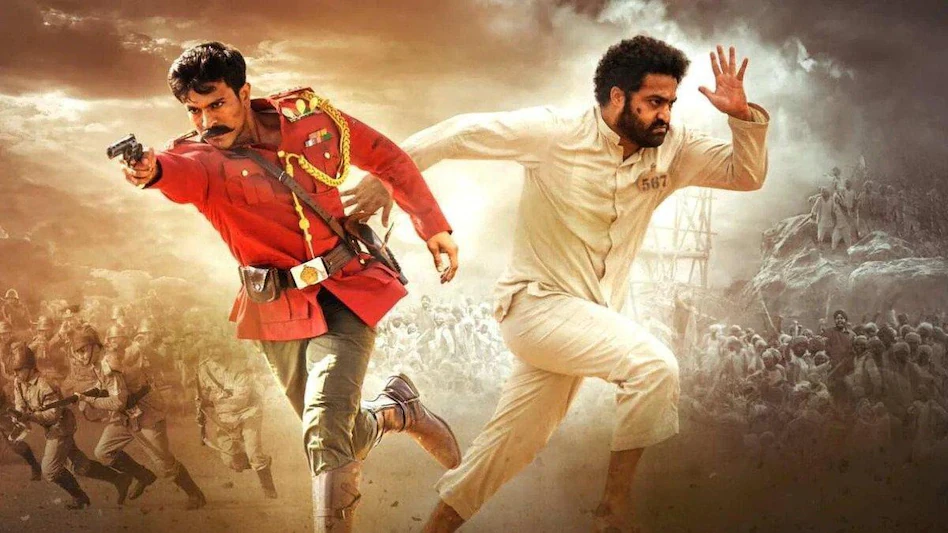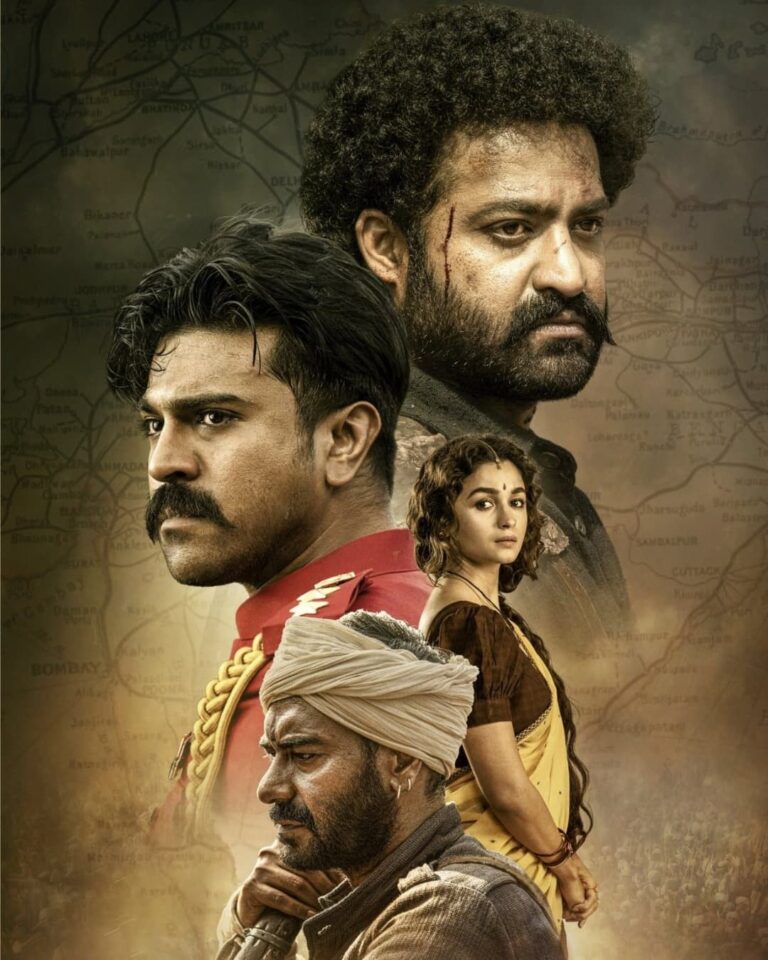RRR – Snapshot
RRR is an over-the-top action movie in the Bollywood tradition. Full of CGI and “James Bond” style choreographed violence, it also has humor, song and dance, history and morality lessons. Three hours of fun. (4*)
Where to Watch:
Stream: Netflix/ZEE5
Rent: (Nowhere)
(Note: Netflix does not offer a Telugu language version – the language it was filmed in. So it is probably best to watch it in Hindi with English subtitles. Unless, of course, you know Hindi and can watch it without subtitles. Or you can do English dubbing, but then the language disconnect is even worse!)
RRR – The Oscar Buzz
Oscar Nominations:
Original Song (“Naatu Naatu”/M.M. Keeravani; Chandrabose) WINNER
RRR received a nomination and won the Oscar for its song “Naatu Naatu”. The Oscar was awarded to composer M.M. Keeravani (composer) and Chandrabose (lyricist). “Naatu” has been translated into English as meaning “Dance” and, indeed, the song appears at about the one hour mark where the two main characters sing and out-dance the pompous British. But, interestingly, the word “Naatu” in its original Telugu meaning is more accurately translated as “native”, “local”, or even “raw and rustic” – meanings that are much more interesting in the context of this movie.
Readers of my previous reviews know I am not fond of this Oscar category, primarily because almost all of the nominated songs show up in the ending credits. Maybe they are to somehow summarize and capture the tone of the film, but they do not, usually, contribute to the film itself. I find that a cheap and unartistic use of musical talent. In this movie, as you might suspect in a film from India, the song and dance is an important element of the movie’s development. So, in this case, this is an entirely appropriate nomination and win! It probably also helped that the “Naatu, Naatu” scene was, for some reason, filmed in Kyiv, Ukraine just a couple of months before the Russian aggression.
From an “Oscar” point of view, though, the question to ask is why wasn’t this movie nominated in other categories? It is the most expensive and elaborate movie ever to come out of India (at least up to 2022), has busted all kinds of box office records, and is very popular among both viewers and critics. India, however, chose not to nominate this film for International Feature and, maybe because it is an Action film, it didn’t get any other nominations either – although it arguably qualified. I’m guessing here, but I suspect Academy members felt a need to recognize this important Indian film somehow and ended up putting it in the Song category. In a lot of ways that’s unfortunate, because this film competes well with many American action movies and should have been recognized as such.
RRR – The Movie’s Family Tree
The Following Movies Share Talent with This One (and if you like these films, you might like this one):
Baahubali: The Beginning (15)/ Baahubali 2: The Conclusion (17)/ Eega (12) : Director/Writer (Rajamouli); Writer (Prasad); Composer (Keeravani); Cinematography (Kumar) ; Production Design (Cyril); Costume Design (Rajamouli)
RRR is, actually, a film from Tollywood, not Bollywood. No, I didn’t understand that either, so I had to look it up. It turns out that the Indian film industry isn’t as monolithic as we might think. While “Bollywood” is often used to refer to any film from India, it properly only refers to those films from India’s dominant Hindi culture. But in fact, India has 22 official languages – imagine the length of government forms there – and one of those languages that has developed its own film industry is Telugu. Hence ‘Tollywood”. S.S. Rajamouli is probably the major filmmaker in this language and has directed and/or written fourteen films starting in 2001 in the Telugu language. RRR is his biggest and most successful movie and was done using a team he had developed over two decades. Interestingly, as here in the U.S., corporate teams often follow family lines: the Composer is his cousin and his wife is the Costume Designer! Having learned all that, I still have to confess that I am unfamiliar with any of his other films, nor of many other films from India – they don’t make it to the Oscars very often! I think that might change in the future.
RRR – What Others Think
RRR is ranked, by viewers, third among all 39 of this year’s Oscar-nominated films. It is behind only Top Gun: Maverick and Tell It Like a Woman. And it is tied with Puss in Boots: The Last Wish. And these ratings are not based on a small number of viewers. Clearly this is a movie that people loved to watch despite its 3+ hour viewing time.
Critics are only slightly less appreciative, ranking the film fifth out of 25 general interest movies. Reviews nearly always remarked on the action aspects and Rajamouli’s appreciation for going big on everything. Simon Abrams (RogerEbert ) called the film “a fine showcase for Rajamouli’s characteristic focus on maximalist action choreography, overwhelming stunt work and pyrotechnics, and sophisticated computer graphics.” James Berardinelli (ReelViews) noted that it “does everything LARGE, whether it’s an action sequence or an emotional connection.” Samuel Wigley (Sight&Sound) commented “…there’s no denying the exuberance coursing through the dilated veins of this spectacular historical epic.” Even the normally staid New York Times critic, Nicolas Rapold, had to admit “Rajamouli shoots the film’s action with hallucinogenic fervor supercharging scenes with a shimmering brand of extended slow motion and CGI that feels less generated than unleashed.”
Overall, audiences and critics together place RRR fourth out of all of 2022’s Oscar nominated films. While I’m not ready to give it quite that high a ranking, I do believe this is a film to see both for its entertainment value and to get a very appreciative understanding of Indian cinema.
RRR – Special Mention
Alluri Sitarama Raju & Komaram Bheem – were the two real-life revolutionaries whom RRR’s main characters are playing. As the film makes clear at the beginning, this is a fictional representation of what might have happened if the two of them had ever actually met. (In real life, they operated in different parts of India and never did half the things pictured in this movie!). Nonetheless, the two real-life men displayed some larger-than-life characteristics.
Sitarama Raju (Ram in the movie) led raids on imperial (British) police stations in order to acquire firearms which he then gave to his “troops”. His troops did indeed fight, mostly, with bows and arrows, and communicated with drums and whistles, exactly like was depicted in the battle scenes of RRR. He was an expert herbal healer and, at the age of eighteen, became a religious ascetic. He also had an early love for a girl named Sita, as depicted in the movie. However in real life, she died young and he added her name to his – becoming Sitarama – as a token to her memory. As in the movie, his father died when he was age 8 (1905), however, counter to RRR, he was a photographer and his death predated the high point of the rebellion. I also found no evidence that Ram ever served as a British police officer and the incredible early scene of his bravery and resilience serving the British to oppress his fellow Indians is, apparently, total fiction. After a two year man-hunt, he was finally captured and summarily executed by firing squad, without a trial, in 1924. To many Indians he was indeed a real-life hero.
Komaram Bheem was another real-life revolutionary hero. He was born and grew up among the Gond tribes and was heavily involved in a type of farming (pondu agriculture) common in those forests which required short term farming followed by migration to another region where resources were fresh to start the process over. The British, trying to enforce their own version of agriculture, outlawed the practice and tried to force the Gonds into permanent residences. The severe implementation of state authority did nothing but goad them to resist and Bheem became one of their leaders. In 1920, Bheem killed – accidentally or not – a man trying to enforce British taxation and Bheem fled the authorities. He, like Ram, developed an almost god-like status among the Gond. Bheem died in 1940, seven years before India achieved independence.
Fire and Water in Hindu Culture – as in many cultures and religious systems, Fire and Water are considered two of the basic elements of our world. Hindi culture typically adds three more, Air, Earth, and Ether (or Akash – which I’m not going to try to explain here). These elements are associated with the senses, one or more of the seven chakras, and multiple other connections in the Hindu culture. Fire is considered the embodiment of transformation, purification, and the upward movement of energy while water is linked more with nourishment, fertility, and the downward movement of energy. The combination of water and fire represents a merging of the physical and spiritual worlds, signifying balance and unity.
Fire and Water appear frequently in RRR, both literally and figuratively. During the first 40 minutes we are explicitly introduced to the “stoRy”, “fiRe”, and “wateR”, making up, again, the title of the film. Fire is explicitly linked to Ram Raju, and Water to Komaram Bheem. In Bheem’s case, there is some justification as he coined the revolutionary slogan “Jal, Jangal, Zameen” which translates to “Water, Forest, Land” and is considered a call to action. The “Fire” link to Ram is not found in the history I’ve uncovered, but, at least in the movie, his fiery actions would justify the association. At any-rate, pay attention to how the story makes use of Fire and Water and the balancing of the two in the relationship between the two main characters.
RRR – Michael’s Moments
RRR was a pleasant surprise. The movies nominated only for a “minor Oscar category” – like Original Song – often don’t have a lot else going for them. But as noted earlier, this film, the most expensive Indian production ever, should probably have been considered in other categories, especially International Feature. While it does have the usual song and dance numbers, right in the middle of otherwise serious scenes – as you expect from Bollywood – it also has pretty good CGI and some action sequence choreography that is simply over the top. At the same time it offers an up-and-down bromance between the two main characters and some, chaste, but fun romantic suggestions with two beautiful women. In short, there is just about a little of everything – except maybe the kitchen sink!
Yes, the 187 minute length is intimidating, but even Joan sat through the whole movie enthralled with the visuals and the back and forth story line. RRR, at times, can be a bit confusing. It employs a lot of flashbacks – and even flashbacks within flashbacks – that are sometimes difficult to keep straight, but it all comes together by the end. The two main characters, Ram and Komaram/Akhtar are presented early-on as humans with unusual strength and resilience in the face of hundreds of opponents, or a single growling tiger. As the story progresses, we see they have points of vulnerability, qualities of care and consideration, and moments of humor. The character development is simply fun, especially as we see them together.
RRR (Rise/Roar/Revolt) is an over-the-top film. The violence in some scenes is tough to take. The British are portrayed, with one exception, as unfeeling fools. CGI is somewhat overdone and sometimes obvious. And the singing and dancing, like many Bollywood films seems to be injected for no apparent reason. But it is movie magic and if you can suspend disbelief for just three hours, you just might enjoy yourself. What more do you want from a movie? (4*)


